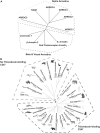Physiological and Pathophysiological Roles of Thioredoxin Interacting Protein: A Perspective on Redox Inflammation and Metabolism
- PMID: 35754346
- PMCID: PMC9968628
- DOI: 10.1089/ars.2022.0022
Physiological and Pathophysiological Roles of Thioredoxin Interacting Protein: A Perspective on Redox Inflammation and Metabolism
Abstract
Significance: Thioredoxin interacting protein (TXNIP) is a member of the arrestin fold superfamily with important cellular functions, including cellular transport, mitochondrial energy generation, and protein cycling. It is the only arrestin-domain protein known to covalently bind to thioredoxin and plays roles in glucose metabolism, inflammation, apoptosis, and cancer. Recent Advances: The crystal structure of the TXNIP-thioredoxin complex provided details about this fascinating interaction. Recent studies showed that TXNIP is induced by endoplasmic reticulum (ER) stress, activates NLR family pyrin domain containing 3 (NLRP3) inflammasomes, and can regulate glucose transport into cells. The tumor suppressor role of TXNIP in various cancer types and the role of TXNIP in fructose absorption are now described. Critical Issues: The influence of TXNIP on redox state is more complex than its interaction with thioredoxin. Future Directions: It is incompletely understood which functions of TXNIP are thioredoxin-dependent. It is also unclear whether TXNIP binding can inhibit glucose transporters without endocytosis. TXNIP-regulated control of ER stress should also be investigated further. Antioxid. Redox Signal. 38, 442-460.
Keywords: TXNIP; arrestin; glucose; inflammasome; redox state; thioredoxin.
Conflict of interest statement
No competing financial interests exist.
Figures






Similar articles
-
Thioredoxin interacting protein: redox dependent and independent regulatory mechanisms.Antioxid Redox Signal. 2012 Mar 15;16(6):587-96. doi: 10.1089/ars.2011.4137. Epub 2011 Dec 20. Antioxid Redox Signal. 2012. PMID: 21929372 Free PMC article. Review.
-
Thioredoxin-Interacting Protein in Cancer and Diabetes.Antioxid Redox Signal. 2022 May;36(13-15):1001-1022. doi: 10.1089/ars.2021.0038. Epub 2021 Oct 7. Antioxid Redox Signal. 2022. PMID: 34384271 Free PMC article. Review.
-
Dl-3-n-Butylphthalide Inhibits NLRP3 Inflammasome and Mitigates Alzheimer's-Like Pathology via Nrf2-TXNIP-TrX Axis.Antioxid Redox Signal. 2019 Apr 10;30(11):1411-1431. doi: 10.1089/ars.2017.7440. Epub 2018 Apr 25. Antioxid Redox Signal. 2019. PMID: 29634349
-
Redoxisome Update: TRX and TXNIP/TBP2-Dependent Regulation of NLRP-1/NLRP-3 Inflammasome.Antioxid Redox Signal. 2024 Apr;40(10-12):595-597. doi: 10.1089/ars.2024.0549. Antioxid Redox Signal. 2024. PMID: 38386512
-
TXNIP: A key protein in the cellular stress response pathway and a potential therapeutic target.Exp Mol Med. 2023 Jul;55(7):1348-1356. doi: 10.1038/s12276-023-01019-8. Epub 2023 Jul 3. Exp Mol Med. 2023. PMID: 37394581 Free PMC article. Review.
Cited by
-
Reduced Thioredoxin Regulates IL-1β Secretion via NLRP3 of IL-1β+ Alveolar Macrophages in COPD.J Inflamm Res. 2025 Jun 30;18:8563-8578. doi: 10.2147/JIR.S513004. eCollection 2025. J Inflamm Res. 2025. PMID: 40620599 Free PMC article.
-
Updated insights into the molecular networks for NLRP3 inflammasome activation.Cell Mol Immunol. 2025 Jun;22(6):563-596. doi: 10.1038/s41423-025-01284-9. Epub 2025 Apr 30. Cell Mol Immunol. 2025. PMID: 40307577 Free PMC article. Review.
-
Covalent binding of thioredoxin to TXNIP is required for diet-induced insulin resistance in the liver.J Biol Chem. 2025 Jun;301(6):110214. doi: 10.1016/j.jbc.2025.110214. Epub 2025 May 8. J Biol Chem. 2025. PMID: 40345590 Free PMC article.
-
An intricate role of Ang II/AT1 in the modulation of monosodium glutamate-induced pulmonary fibrosis by TGF-β/Smad through quercetin.Sci Rep. 2025 Jul 1;15(1):21112. doi: 10.1038/s41598-025-05781-9. Sci Rep. 2025. PMID: 40594711 Free PMC article.
-
DPEP Inhibits Cancer Cell Glucose Uptake, Glycolysis and Survival by Upregulating Tumor Suppressor TXNIP.Cells. 2024 Jun 12;13(12):1025. doi: 10.3390/cells13121025. Cells. 2024. PMID: 38920655 Free PMC article.
References
-
- Benovic JL, Kühn H, Weyand I, et al. . Functional desensitization of the isolated beta-adrenergic receptor by the beta-adrenergic receptor kinase: Potential role of an analog of the retinal protein arrestin (48-kDa protein). Proc Natl Acad Sci U S A 1987;84(24):8879–8882; doi: 10.1073/pnas.84.24.8879 - DOI - PMC - PubMed
Publication types
MeSH terms
Substances
Grants and funding
LinkOut - more resources
Full Text Sources

